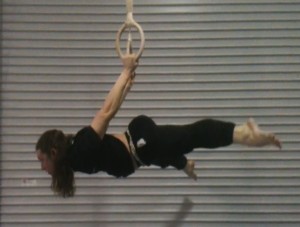Been having lots of fun in my recent park workouts. Here is a video on me doing a Clutch Flag.
Clutch Flag
To be honest, I had never seen nor heard of this version of the human flag, until I read Convict Conditioning 2.
Anyone with a good level of strength should be capable of doing the clutch flag with a small amount of work. It is recommended to master this movement before you even move into the human flag (called press flag in that book). I think this is very sound advice.
The basics of it are to wedge one elbow (the lower arm) into the hip. This helps support the body. The other arm wraps around the bar and pulls back, while you lever out your body.
Because you’re wrapped around the bar, and don’t have your arms extended, the leverage of this movement is way easier. Yet you still need to control your body in this side levering movement, and you can even get use to your body wanting to turn or sway in the air.
My friend and I plan on building up the time in this movement to at least 20 seconds before we really get started on the human flag. That’s of course for both sides. I feel a little stronger on the side shown in the video (I guess I’ll call that the right side) but not too far behind with the other.
It should go without saying that to practice this move, be sure you’re on a steady bar that can support your weight and will not topple over. Sign posts, swings sets, basketball poles and much more will work.
And this move is uncomfortable in the beginning. It can hurt a little to grab the bar as you tense up completely against it. Yet after a few days working on this, while I wouldn’t call it comfortable, it is manageable at this point.
I haven’t done a full review on Convict Conditioning 2 yet, but if you’ve like to read the original Convict Conditioning review its still one of the most popular posts on my site.
The clutch flag is also a very different movement from the shoulder flag which I learned from the Tapp Brothers in their course. When I use to think of the human flag as one movement, its clear there are many routes and similar, yet easier, movements to work on.







